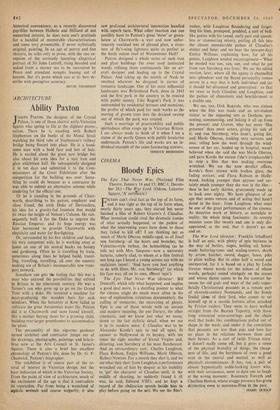ARCHITECTURE
Ability Paxton
JOSEPH PAXTON, the designer of the Crystal Palace, is one of those electric early-Victorian figures who spring to life at the slightest provo-
cation. There he is standing with Robert Stephenson on the banks of the Menai Strait
watching the third tube of Stephenson's railway bridge being floated into place. He is a hand- some man with a bold face and lots of hair. Tie is excited about the great new bridge but also about his own idea for a vast iron and glass exhibition hall. He subsequently designed it in ten days and submitted it to the Com- missioners of the Great Exhibition after the competition for the building was over. Some- thing he could do because as a contractor he was able to submit an alternative scheme while tendering for the official one.
Or be is standing in the grounds of Chats- worth, describing to his patron, employer and close friend, the sixth Duke of Devonshire, his idea for a gravity-fed fountain that would jet twice the height of Nelson's Column. He sub- sequently built it for the Duke to impress the Russian Emperor, and its huge energy was later harnessed to provide Chatsworth with electricity and water for fire-fighting.
Or, suriounded by his five children and Sarah, his very competent wife, he is working away at home on one of his several books on botany and gardening. Often he is travelling by train, sometimes along lines he helped build, travel- ling, travelling, travelling, all over the country making use of Britain's incomparable new trans- port network.
Somehow one gets the feeling that this was a man who enjoyed the possibilities that existed in Britain in the nineteenth century. He was a farmer's son who grew up to go on the Grand Tour with a duke. He invented a machine for mass-producing the wooden bars for sash windows. When the botanists at Kew failed to cultivate the great Amazonian water lily, Paxton did it at Chatsworth and soon found himself, like a mother buying shoes for a growing child, building ever-larger greenhouses to accommodate the plant.
The personality of this vigorous gardener turned architect and contractor jumps out of the drawings, photographs, paintings and bric-a- brac now at the Arts Council in St. James's Square. There is also a brief but excellent chronology of Paxton's life, done by Dr. G. F. Chadwick, Paxton's biographer.
The exhibition is of course part of the re- vival of interest in Victorian design, not the least indication of which' is the Victorian Society. From the point of view of architecture, much of the excitement of the age is that it contradicts its reputation. Far from being a wasteland of stylistic revivals and coarse vulgarity, it also saw profound architectural innovation handled with superb taste. What other reaction can one possibly have to Paxton's great 'stove' or green- house at Chatsworth—a vast and now unfor- tunately vanished tent of pleated glass, a struc- ture of fly's-wing lightness quite as perfect as the burly oaken roof of Westminster Hall?
Paxton designed a whole series .of such iron and glass buildings (he even used laminated wood), refining them continuously like an air- craft designer and leading up to the Crystal Palace. And taking up the mantle of Nash he swathed whatever he designed in curves of romantic landscape. One of his most influential landscapes was Birkenhead Park, done in 1843 and the first park in the country to be created with public money. Like Regent's Park it was surrounded by residential terraces and mansions, the profits of which paid for such works as the moving of grown trees into the drained swamp out of which the park was created.
Such a marriage of practicability and public spiritedness often crops up in Victorian Britain. I am always made to think of it when I see a statue of the portly Queen with public lavatories underneath. Paxton's life and works are an in- dividual example of the same fascinating mixture.
- TERENCE BENDIXSON






























 Previous page
Previous page